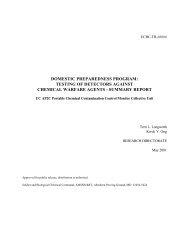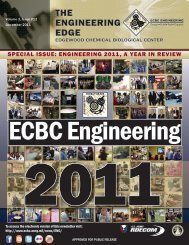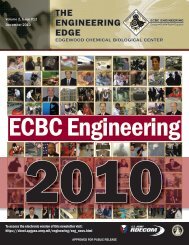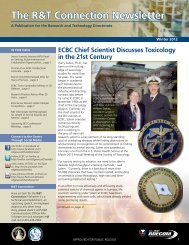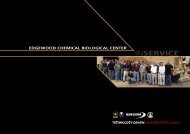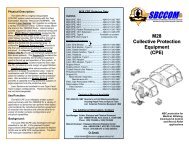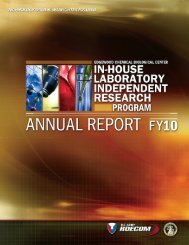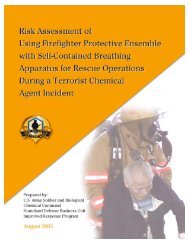The engineering edge - Edgewood Chemical Biological Center
The engineering edge - Edgewood Chemical Biological Center
The engineering edge - Edgewood Chemical Biological Center
You also want an ePaper? Increase the reach of your titles
YUMPU automatically turns print PDFs into web optimized ePapers that Google loves.
Volume 3, Issue #6<br />
June 2011<br />
<strong>The</strong><br />
Engineering<br />
Edge<br />
EdgeWood <strong>Chemical</strong> <strong>Biological</strong> <strong>Center</strong><br />
ECBC’s Detection Engineering Branch<br />
Partners with Japan Ministry of Defense<br />
to Improve Military <strong>Chemical</strong> Operations<br />
ABOVE: Engineering’s Bill Argiropoulos<br />
discusses testing details with one of<br />
the Japanese test participants. TOP:<br />
Participants from February’s PACAD user<br />
assessment patiently wait for results during<br />
a test that compared the automated results<br />
from the PACAD to the manual M526A1.<br />
<strong>The</strong> U.S. Army <strong>Edgewood</strong><br />
<strong>Chemical</strong> <strong>Biological</strong><br />
<strong>Center</strong> (ECBC) Detection<br />
Engineering Branch (DEB)<br />
and the Japan Ministry of<br />
Defense (MOD), Technical<br />
Research and Development<br />
Institute, Advanced Defense<br />
Technology <strong>Center</strong> (TRDI-<br />
ADTeC) have continued<br />
to partner together on<br />
a Cooperative Research<br />
Project to improve an existing<br />
chemical agent detector.<br />
<strong>The</strong> two partners agreed to<br />
the project’s Memorandum<br />
of Understanding (MOU)<br />
objectives to research,<br />
design, fabricate and test<br />
a chemical agent detector<br />
prototype herein called<br />
the Palm-sized Automated<br />
<strong>Chemical</strong> Agent Detector<br />
(PACAD) based on the<br />
chemistry of the U.S. M256A1<br />
<strong>Chemical</strong> Agent Detector and<br />
Japanese expertise in microfluidic,<br />
electro-optical, and<br />
miniaturization technologies.<br />
TRDI-ADTeC is the lead for<br />
the fabrication efforts while<br />
ECBC DEB is the lead for the<br />
testing efforts of the PACAD<br />
prototypes. As part of a<br />
recent visit by TRDI-ADTeC,<br />
ECBC DEB hosted various<br />
activities at Aberdeen Proving<br />
Ground (<strong>Edgewood</strong> Area),<br />
Maryland.<br />
A two-day user-based<br />
assessment of the PACAD<br />
(Continued on page 7)<br />
2011 Strategic Management<br />
Meeting shows the value of<br />
Engineering’s Balanced Scorecard<br />
Strategy<br />
<strong>The</strong> Engineering Directorate conducted its eighth Strategic<br />
Management Meeting (SMM) on May 3 as part of the<br />
implementation of the Balanced Scorecard (BSC) strategic<br />
planning process. <strong>The</strong> quarterly SMM provides a forum for<br />
initiative teams within the Engineering Directorate to present<br />
their progress to the senior leadership and receive feedback.<br />
Facilitated by Ed Bowen, Engineering Directorate Chief of<br />
the Strategic Planning and Business Operations Branch, the<br />
Engineering Directorate uses the SMM to measure progress<br />
against the strategy and guide (Continues on page 6)<br />
BACK ROW FROM LEFT (PRIDE<br />
Team Members): Mark Ciampaglio,<br />
Roderick Fry, Vicky Bevilacqua.<br />
FRONT ROW FROM LEFT (PRIDE<br />
2011 Participants): Evalena Foster,<br />
Dominique McClain and Troy<br />
Thompson.<br />
Engineering’s<br />
PRIDE<br />
Program<br />
Offers ECBC<br />
Workforce<br />
New Career<br />
Development<br />
Opportunities<br />
Since its strategy<br />
development process<br />
began in 2005,<br />
Engineering Directorate<br />
staff has remained<br />
engaged because the strategy itself is relevant and accessible.<br />
Just ask Roderick A. Fry, Ph.D., ECBC Chemist and a team<br />
member on one of the Engineering strategy’s newest initiatives<br />
– the Progressive Rotational Inter-Divisional Exchange (PRIDE)<br />
Program.<br />
“<strong>The</strong> PRIDE program exemplifies the kind of practical application<br />
and growth initiatives that are offered via the [Engineering]<br />
Balanced Scorecard strategic (Continues on page 2)<br />
To access the electronic version of this newsletter visit:<br />
http://www.ecbc.army.mil/news/ENG/<br />
..<br />
APPROVED FOR PUBLIC RELEASE
Page 2<br />
Inside This<br />
Month’s<br />
Issue:<br />
PRIDE Offers Workforce<br />
Career Development<br />
Opportunities 2<br />
Engineering<br />
Recognized for 10 years<br />
of Support to<br />
SS CB Program 3<br />
Engineering BSC Military<br />
Appreciation Event<br />
Draws Over 100 from<br />
Across the <strong>Center</strong> 4-5<br />
Strategic Management Meeting<br />
Shows Value of BSC 6<br />
Employee Spotlight:<br />
Gloria Morales 6<br />
DEB Partners with Japan<br />
in PACAD Development 7<br />
This newsletter was<br />
published through the<br />
Balanced Scorecard.<br />
For article suggestions,<br />
questions or comments<br />
please contact Ed Bowen at<br />
ed.bowen@us.army.mil.<br />
PRIDE Offers Workforce Career Development Opportunities<br />
(Continued from page 1)<br />
management process,” Fry said. “It decentralizes the Directorate’s strategic planning, allowing the<br />
workforce to bring ideas like PRIDE to leadership for consideration, develop the program and receive the<br />
needed buy-in and support from senior management.”<br />
<strong>The</strong> structure of the Engineering strategy calls for continuous efforts to educate individuals about<br />
strategic initiatives and these initiatives seek to improve daily operations for the workforce — including a<br />
specific initiative like PRIDE that provides ECBC’s “rising stars” the opportunity for career development<br />
and to gain valuable perspective within the <strong>Center</strong>.<br />
Currently, PRIDE is designed for GS-11/12s in the CP-16 career field to gain diversified experience within<br />
the Engineering Directorate. It consists of two consecutive six-month rotational assignments in branches<br />
outside of the employee’s current division.<br />
PRIDE kicked off its first pilot rotation on May 11 at the monthly ECBC Supervisors Brown Bag meeting,<br />
with a formal presentation of the program made by Engineering Executive Officer Vicky Bevilacqua. At<br />
the meeting, Bevilacqua introduced ECBC leadership to the first three PRIDE participants: Evalena Foster<br />
from the Joint Service Collective Protection Branch, Dominique McClain from the Electronic Design and<br />
Integration Branch and Troy Thompson from the Decontamination Engineering Branch.<br />
“<strong>The</strong> idea is that participants will return to their home branch with diversified knowl<strong>edge</strong> and experience<br />
that will ultimately better serve ECBC’s customers,” Bevilacqua said. (Continues on page 3)<br />
Awareness: Father’s Day, June 19th<br />
Although Father’s Day was not declared official until 1966 by<br />
President Lyndon B. Johnson, the origin of Father’s Day dates all the<br />
way back to 1910. On June 19, 1910, an independently-invented<br />
Father’s Day observance was celebrated through the efforts of<br />
Sonora Smart Dodd of Spokane, Washington. After listening to a<br />
church sermon at Spokane’s Central Methodist Episcopal Church in<br />
1909 about the newly recognized Mother’s Day, Dodd felt strongly that fatherhood needed recognition,<br />
as well. She wanted a celebration that honored fathers like her own father, William Smart, a Civil War<br />
veteran who was left to raise his family alone when his wife died giving birth to their sixth child when<br />
Sonora was 16 years old.<br />
It took many years to make the holiday official. In spite of support from the YWCA, the YMCA, and<br />
churches, Father’s Day ran the risk of disappearing from the calendar. Where Mother’s Day was met<br />
with enthusiasm, Father’s Day was often met with laughter. <strong>The</strong> holiday was gathering attention slowly,<br />
but for the wrong reasons. It was the target of much satire, parody and derision. A bill to accord national<br />
recognition of the holiday was introduced in Congress in 1913. In 1916, President Woodrow Wilson<br />
went to Spokane to speak in a Father’s Day celebration and wanted to make it official, but Congress<br />
resisted, fearing that it would become commercialized. It wasn’t until 1966 that President Lyndon B.<br />
Johnson issued the first presidential proclamation honoring fathers, designating the third Sunday in<br />
June as Father’s Day. Six years later, the day was made a permanent national holiday when President<br />
Richard Nixon signed it into law in 1972.<br />
Writing Tip of the Month<br />
This month’s writing tip was submitted by Engineering’s John Kennedy.<br />
“As to the adjective, when in doubt, strike it out.” ~ Mark Twain<br />
Mr. Twain was right. Adjectives are overused. <strong>The</strong> words very, great, many, several,<br />
few, some, quite, big, little, bad, good, excellent, beautiful, wonderful, awesome,<br />
interesting, amazing, and powerful are examples of adjectives that could be<br />
dropped when in doubt. <strong>The</strong>re are more.<br />
Mr. Twain’s advice is not only appropriate for adjectives. It can be applied to<br />
overused adverbs as well. Very, really, totally, actually, usually, quickly, greatly,<br />
beautifully, amazingly, so, just, surprisingly, interestingly, hopefully, awfully, and<br />
absolutely come to mind. <strong>The</strong>re are more.<br />
APPROVED FOR PUBLIC RELEASE
Page 3<br />
PRIDE Offers Workforce Career<br />
Development Opportunities<br />
(Continued from page 2)<br />
<strong>The</strong> idea for the program was birthed out of a 2010 Leadership Cohort project.<br />
Bevilacqua and Fry are two of the six PRIDE team members who helped design<br />
the program and now voluntarily manage it. Other members include Engineering’s<br />
Mark Ciampaglio and Michael Palko, and Directorate of Program Integration’s<br />
Nancy Pusey and Elaina Taylor. Realizing the potential for the program, the team<br />
began circulating the idea amongst the Engineering Directorate’s strategic planning<br />
Core Team as a possible initiative. As a tangible means to execute against one of<br />
the BSC’s four key Perspectives – People, Learning and Growth – the BSC Core<br />
Team was quick to approve PRIDE as an official initiative under the strategy.<br />
“This is the kind of strategic planning any organization’s leadership likes to<br />
see – initiatives whose inception begins with members of the workforce,” said<br />
Engineering Directorate Chief of the Strategic Planning and Business Operations<br />
Branch, Ed Bowen. “When this happens, there is a greater sense of ownership in<br />
the strategic planning process; it’s not just a mandate from leadership.”<br />
2011 PRIDE PARTICIPANTS FROM LEFT<br />
TO RIGHT: Evalena Foster, Dominique<br />
McClain and Troy Thompson.<br />
<strong>The</strong> PRIDE team is following<br />
a phased approach to roll out<br />
the program. <strong>The</strong> first phase, a<br />
pilot rotation, began in May and<br />
will end May 2012. In Phase I<br />
the employee exchange takes<br />
place between three divisions<br />
in the Engineering Directorate.<br />
In Phase II, the program will<br />
broaden its scope and will<br />
incorporate exchanges within<br />
ECBC’s Directorate of Program<br />
Integration and Research and<br />
Technology Directorate. Finally,<br />
the hope is that in Phase III,<br />
perhaps three years down the<br />
road, PRIDE will allow for exchanges between the Joint Program Executive Office<br />
for <strong>Chemical</strong> and <strong>Biological</strong> Defense (JPEO-CBD) until the program evolves to<br />
exchanges between the JPEO-CBD and ECBC’s three Directorates.<br />
“PRIDE offers numerous benefits not just for the employee, but for the <strong>Center</strong>,”<br />
Ciampaglio said. “Employees will be returning to their home branches with<br />
broadened perspectives and improved organizational awareness. And their<br />
expanded network will provide for improved customer service and greater<br />
opportunities for improved collaboration across divisions.”<br />
According to McClain, a newcomer to ECBC, the potential for increased efficiency<br />
through the sharing of best practices is great.<br />
“One of the things that attracted me to this program was the opportunity it created<br />
for the interchange of ideas and best practices. I see it as a chance to improve<br />
upon my current skill set, a new learning opportunity,” McClain said.<br />
Foster has worked within the <strong>Edgewood</strong> <strong>Chemical</strong> <strong>Biological</strong> <strong>Center</strong>’s Engineering<br />
Directorate for eight years. When she filled out the personal application for PRIDE<br />
last year, she was eager to diversify her own career experience.<br />
“I was looking to get more hands-on experience outside of my current scope of<br />
work, to network and to become more knowl<strong>edge</strong>able of the acquisition process as<br />
a whole,” Foster said. “PRIDE was the perfect opportunity to do that.”<br />
Thompson hopes to come away with a broadened perspective of ECBC and a<br />
greater sense of the diverse expertise offered within the <strong>Center</strong>.<br />
“I wanted more exposure to the areas of expertise offered at ECBC. PRIDE offers<br />
me the ability to get that ‘big picture’ idea of what’s happening in the <strong>Center</strong>, and<br />
in turn will allow me to work more effectively within my home branch.”<br />
For more information about PRIDE, please contact PRIDE at:<br />
ecbc.pride@us.army.mil.<br />
Engineering Recognized for 10<br />
years of Support to SS CB Program<br />
After ten years of supporting the U.S. Secret Service (SS) as<br />
program manager overseeing a special chemical and biological<br />
(CB) facility, the Engineering Directorate’s support of the<br />
program has concluded with the decommissioning of the SS’s<br />
old facility and the successful transition of the customer’s<br />
program to a new location in the Washington, D.C. area.<br />
In recognition of Engineering’s significant contributions of<br />
expertise and support, the SS honored several of the key<br />
ECBC individuals involved in the program at a special awards<br />
ceremony in May, held in the Berger Auditorium. Individuals<br />
recognized included Suzanne Milchling, Director of Program<br />
Integration, formally Engineering Associate Director when<br />
she led the effort from 2002-2010. Other members of the<br />
Engineering Directorate were honored as well during the<br />
ceremony.<br />
“One of the new monikers we are putting forth at the new facility<br />
comes from the reputation that ECBC Engineering established<br />
over the past ten years – ‘100% right, 100% of the time,’”<br />
said one SS representative as she thanked the group of ECBC<br />
Engineering individuals gathered for the ceremony.<br />
Although Engineering’s support of the program is concluding,<br />
the new facility will continue to be supported by the Directorate<br />
of Program Integration (DPI), who remains a key player. <strong>The</strong><br />
Research and Technology (R&T) Directorate will also support the<br />
new facility as needed.<br />
Key individuals from ECBC who supported the SS program also<br />
include Bill Klein, Engineering Associate Director, who helped<br />
get the program on its feet.<br />
“<strong>The</strong> success of the program is a tribute to all of ECBC who<br />
collaborated together across the Directorates to make the<br />
program work,” Klein said.<br />
Members of an Engineering team that supported a<br />
classified program for the U.S. Secret Service from 2001-2011<br />
were recognized for their work at a special awards ceremony<br />
in May.<br />
ECBC performed multiple functions in support of the program.<br />
<strong>The</strong> Engineering Directorate was the program manager and<br />
handled the day to day operations of the facility, including<br />
all contractors. DPI was used extensively for lab support;<br />
monitoring, filtration and environmental support; safety and risk<br />
expertise; and the decommissioning of the old facilities. R&T<br />
provided testing support and technical expertise.<br />
According to members of the SS program, ECBC was the best<br />
fit for the client as the <strong>Center</strong> offered the broadest range of CB<br />
expertise, the greatest number of CB facilities and a diverse<br />
workforce with extensive hands on experience in the CB area.<br />
APPROVED FOR PUBLIC RELEASE
Page 4<br />
ENGINEERING’S BSC “MILITARY<br />
APPRECIATION DAY” EVENT DRAWS 100+<br />
ATTENDEES FROM ACROSS THE CENTER...<br />
Engineering Hosts Military<br />
Appreciation event to Honor National<br />
Armed Forces Month<br />
On May 16, the <strong>Edgewood</strong> <strong>Chemical</strong> <strong>Biological</strong> <strong>Center</strong> (ECBC) honored those<br />
members of the ECBC workforce who have served, or are currently serving, in<br />
the United States military with the first “ECBC Military Appreciation Day.” Over<br />
90 individuals turned out to participate in the event, with all of the <strong>Center</strong>’s<br />
senior leadership in attendance. <strong>The</strong> event featured remarks from several<br />
prominent members of the ECBC workforce, and a group presentation of<br />
“ECBC Certificates of Appreciation” for individuals in the ECBC workforce who<br />
wished to be recognized for their military service.<br />
Joseph Wienand, ECBC Technical Director began the event by welcoming<br />
the workforce saying, “I am really proud to be here and recognize these<br />
outstanding members of our workforce. When you have a shared<br />
experience…it’s like a fraternity, a brotherhood.”<br />
Wienand lightheartedly spoke of old habits from the military that are still part<br />
of his daily routine saying, “I learned some of my most valuable lessons while<br />
in the military and they have stuck with me…Every morning when I look in the<br />
mirror, I still make sure I check my gig line.”<br />
Following the welcome and opening remarks, Wienand was joined by five<br />
other guest speakers, each sharing their experiences and lessons learned<br />
from time in the military.<br />
Dr. Augustus Fountain, Senior Research Scientist from the Research and<br />
Technology Directorate provided words of wisdom to the audience. “In the<br />
military, there are no individuals. You succeed and fail as an organization,”<br />
said Fountain. He continued by saying you should be focused on the<br />
preparation and improvement—you should always leave your position better<br />
than you found it. His last lesson was, “It can always be worse.”<br />
Mary Hubbard, Deputy Product Manager for the Joint Service Aircrew Mask-<br />
Rotary Wing Program agreed with Dr. Fountain’s interpretation of military<br />
wisdom when saying “it can always be worse.” Hubbard recalled a time<br />
in the National Guard when she was battling with flood mitigation in Iowa,<br />
saying, “I lived in a bathroom with 1,300 infantrymen for several weeks…<br />
it can always be worse.” Hubbard has utilized her Army experiences to be a<br />
better civil servant and taking a no-nonsense approach to asking questions<br />
and inquiring about solutions at ECBC. “I appreciate what ECBC has done for<br />
me personally, professionally and helping me to support our warfighter in the<br />
future,” she said.<br />
Colonel Althouse, Military Deputy of ECBC admitted that the Army was his<br />
“ticket out of Beaver Creek, Ohio.” Thirty-four years later, he still serves in a<br />
role within the Army, saying, “That’s probably one of the reasons I’ve served<br />
so long…because of the people.”<br />
Debra <strong>The</strong>dford, Associate Director, DPI Business Management and<br />
APPROVED FOR PUBLIC RELEASE
Page 5<br />
Integration has maintained an Army affiliation for much the same reason.<br />
<strong>The</strong>dford retired from active duty not too long ago after 27 years, 9 months and<br />
14 days of military service. She admits, “I would do it all over again if I could.”<br />
Dr. James Baker capped off the afternoon with a discussion of how ECBC,<br />
Aberdeen Proving Ground, and the Army have evolved in the years since he<br />
started here in November 1969. His stories of active duty past and his current<br />
civil service portrayed his commitment and dedication to the Army.<br />
Following the guest speakers’ remarks, Wienand asked the members of the<br />
audience with military experience to stand and be recognized, saying, “We<br />
commend you for your service to our country. Thank you for all that you have<br />
done and continue to do to defend our Nation.”<br />
Director of Engineering AJay Thornton closed the event by presenting Wienand<br />
with a certificate signed by RDECOM Commander Major General Nick Justice,<br />
recognizing ECBC for its patriotic recognition of members of its workforce that<br />
have defended our country through military service.<br />
“ECBC Military Appreciation Day 2011” was sponsored by Engineering<br />
Directorate’s Balanced Scorecard Strategy as part of several Engineering<br />
Directorate initiatives to honor the service of men and women in the military.<br />
Event handouts included a special themed May issue of the “Engineering<br />
Edge” newsletter celebrating “National Armed Forces Month,” and a<br />
commemorative slide show featuring photographs of ECBC employees’ time in<br />
the military.<br />
<strong>The</strong> newsletter and commemorative slideshow will be available on the ECBC<br />
website at www.ecbc.army.mil. In addition, video clips, photos from the event,<br />
and guest blog entries will be made available on Facebook, YouTube, Flickr and<br />
ECBC’s blog (http://<strong>edge</strong>woodchembio.blogspot.com).<br />
For more information about Engineering Directorate’s strategy please contact<br />
Ed Bowen at ed.bowen@us.army.mil.<br />
If you were unable to attend the event AND would like to revisit mr. wienand’s address and the guest<br />
speakers’ remarks, we invite you to visit the Military Appreciation Online Forum, hosted on ECBC’s SharePoint. <strong>The</strong> entire video of<br />
the event and event handouts can be found on a special forum web page, accessible from the Engineering SharePoint homepage.<br />
We invite you to continue the dialogue online via the provided forum, posting additional follow-up comments related to the topics<br />
discussed at the May event.<br />
If you have any questions about the event or the SharePoint forum, please contact Ed Bowen at ed.bowen@us.army.mil.<br />
<strong>The</strong> 2011 Military Appreciation Day event guest speakers (FROM LEFT TO RIGHT): Dr. Augustus Fountain, Senior Research<br />
Scientist from the Research and Technology Directorate; Joseph Wienand, ECBC Technical Director; Colonel Althouse, Military<br />
Deputy of ECBC; Dr. James Baker, Associate Director, ECBC; Debra <strong>The</strong>dford, Associate Director, DPI Business Management<br />
and Integration; Mary Hubbard, Deputy Product manager for the Joint Service Aircrew Mask-Rotary Wing Program.<br />
APPROVED FOR PUBLIC RELEASE
Page 6<br />
Employee Spotlight Series:<br />
A conversation with Gloria Morales,<br />
Laboratory Quality Control Coordinator,<br />
Protective Equipment Test Branch<br />
Gloria Morales provides a<br />
brief demonstration for a group<br />
of school students during the<br />
2011 Aberdeen Proving Ground<br />
Armed Forces Day on May 18.<br />
For this installment of the<br />
Engineering Edge Employee<br />
Spotlight Series, we talked to<br />
Gloria Morales, Laboratory<br />
Quality Control Coordinator for the<br />
Protective Equipment Test Branch,<br />
about her role and responsibilities<br />
at ECBC.<br />
Engineering Edge: How long have<br />
you been at ECBC?<br />
Gloria Morales: Out of my 14 years<br />
of government service, eight have<br />
been with ECBC.<br />
EE: What are your current job title and responsibilities?<br />
GM: I am a chemist and the Laboratory Quality Control Coordinator<br />
(LQCC) for the Protective Equipment Test (PET) Branch. I work with the<br />
Quality Manager and the Branch Chief to manage, plan, coordinate, and<br />
direct the quality control program. It is my responsibility to maintain the<br />
technical quality and reliability of data for testing services provided by<br />
PET. This involves ensuring compliance with our internal quality control<br />
procedures and the guidelines within our accreditation to International<br />
Organization for Standardization Standard 17025.<br />
EE: What is a highlight about your current job at ECBC - something<br />
you look forward to each day when you come to work?<br />
GM: My motivation is two-fold. My dad has always talked about duty and<br />
taking pride in what you do. What I do matters; it has an impact on the<br />
Warfighter. I am proud of what I do. <strong>The</strong> other highlight of my job is the<br />
people I work with, my co-workers. I work with a great group of people.<br />
EE: What is one of the most exciting projects you’ve worked on while<br />
at ECBC?<br />
GM: That is a tie between the drink bag project and a decontamination<br />
project. <strong>The</strong> first aimed at testing the permeation resistance of different<br />
types of bladders. Water inside the bladders was sampled and tested<br />
at various time intervals for the presence and amount of chemical<br />
agents. <strong>The</strong> purpose of the decontamination test was to find out if the<br />
application of a specific amount of decontaminant for a specified time<br />
was enough to clear certain materials.<br />
EE: What are your hobbies outside of work?<br />
GM: Continuing some of mine and my husband’s collections (DVD/VHS<br />
movies, comics, collectible figures, Barbie, etc.), jewelry making, wine<br />
tastings and trying to honor my late husband’s wishes.<br />
Was your last Engineering team photo taken when<br />
cassette tapes were the hottest music media? Has it<br />
been at least two years since you’ve last updated your<br />
team’s photo inventory? Does your team have any<br />
upcoming events or happenings that you would like to capture photos<br />
of? If you answered yes to any of these questions, we invite you to<br />
schedule a photo shoot with the Engineering Communications team. To<br />
coordinate a time, please contact Ed Bowen at ed.bowen@us.army.mil.<br />
APPROVED FOR PUBLIC RELEASE<br />
2011 Strategic Management Meeting<br />
(Continued from page 1)<br />
continued BSC efforts. Status briefings are presented to Engineering’s<br />
BSC Board of Directors, which provides oversight, guidance and<br />
accountability for strategy implementation efforts.<br />
“To quote a German proverb, ‘What’s the use of running if you are not<br />
on the right road?’” Bowen said during the meeting. “<strong>The</strong>se meetings<br />
are a reminder that our organization must be on the right road;<br />
otherwise we will be on a road to nowhere.”<br />
This year’s SMM continued with the different approach established at<br />
last years’ November meeting, focusing on a group of initiatives with<br />
significant results to report. Presenters briefed progress for initiatives<br />
that touched all four BSC Perspectives – Core Competencies; Internal<br />
Processes; People, Learning and Growth; and Resources. Engineering’s<br />
BSC Board of<br />
Directors commented<br />
on the value of<br />
connections between<br />
initiatives, noting that<br />
shared progress and<br />
partnerships across<br />
the Directorate would<br />
continue to have<br />
positive results.<br />
“Strategy is an<br />
opportunity to be part<br />
of the organization’s<br />
future,” said AJay<br />
Thornton, Director<br />
of Engineering.<br />
“We want you to<br />
participate, and<br />
encourage your<br />
coworkers to<br />
participate. Next time<br />
you come to one<br />
of our BSC events,<br />
bring a friend with<br />
you – that’s how we<br />
are going to continue<br />
making a positive<br />
difference in our<br />
organization.”<br />
Leading off the<br />
briefings pertaining<br />
to specific BSC<br />
initiatives, Bowen<br />
stood in for initiative<br />
lead Leanne<br />
Chacon, briefing on<br />
“Developing and<br />
Implementing a<br />
Networking Program<br />
for Professional<br />
Uses.” He reviewed<br />
TOP: Engineering Director AJay Thornton<br />
greets individuals as they make their way<br />
into the Berger Auditorium for the May 3<br />
Engineering Strategic Management Meeting.<br />
ABOVE: Engineering’s Angela Florea shakes<br />
hands with Thornton as she receives the<br />
“Balancing the BSC” award. Florea was one<br />
of six individuals from the BSC R3, Initiative 2<br />
“Budget Submission Template” to receive the<br />
award for their significant contributions to the<br />
Directorate’s strategy.<br />
several of the efforts the team has instituted including the Sports<br />
League, “Tuesdays With…” series and the 2010 Summer Fitness<br />
Challenge. <strong>The</strong> initiative team recommended that the initiative be<br />
closed out due to the successful completion of all initiative goals.<br />
Following Bowen, several individuals reported updates pertaining<br />
to workforce development initiatives. Allen Swim, Deputy Product<br />
Director for Ground Mobile Platform <strong>Chemical</strong> <strong>Biological</strong> Radiological<br />
Survivability for Major Defense Acquisition (Continues on page 8)
Page 7<br />
Detection Engineering Partners with Japan in PACAD Development<br />
(Continued from page 1)<br />
prototype was conducted from February 28 – March 1, 2011. Four soldiers representing the user’s community from various local U.S. Army Reserve<br />
units participated in the assessment and provided documented feedback on the PACAD’s functional capabilities and desired features as compared to<br />
that of the baseline M256A1 <strong>Chemical</strong> Agent Training kit.<br />
“<strong>The</strong> overall ease of operation for the PACAD is much better compared to the M256A1,” said SGT Ryan Waters, a CBRN Non-Commissioned Officer<br />
(74DL4), U.S. Army Reserve, 130th <strong>Chemical</strong> Company (<strong>Biological</strong> Integrated Detection System).<br />
CPT Gordon, an Environmental Health Scientist (72D), U.S. Army Reserve Consequence Management Unit, commented on the fewer procedures by the<br />
operator and the elimination of manually crushing the ampoules as a potential benefit of the PACAD prototype. A soldier of TRDI, MOD, Japan joined the<br />
four U.S. soldiers to operate the prototype during the assessment comparison trials with the baseline M256A1 Training Kit. General Engineer from ECBC<br />
DEB Phyllis Brown commented on her observation of the soldiers after receiving training on the PACAD prototype. Brown is responsible for coordinating<br />
and implementing the assessment<br />
“Soldiers serving in the Armed Forces today are used to technology to help them do their jobs more efficiently,” Brown said. “<strong>The</strong> PACAD prototype is no<br />
different. I observed the soldiers’ appreciation for the automated process as they multi-tasked while waiting on the prototype to provide the detection<br />
results.”<br />
ECBC DEB hosted their semi-annual Joint Working Group and Joint Steering Committee meetings during March 2-3 and March 4, 2011, respectively.<br />
U.S. Lead PACAD Project Engineer Mike Palko coordinates many of these meetings with international partners and the ECBC International Office to make<br />
sure things come together seamlessly.<br />
“It’s a very rewarding experience to coordinate the many aspects of the project with our international partners and U.S. agencies, then directly<br />
participate in the project activities to successfully achieve the project goals and milestones as things progress forward,“ Palko explained.<br />
ABOVE LEFT: Test participants situate their protective masks as they prepare for another user assessment<br />
ABOVE RIGHT: <strong>The</strong> Detection Engineering Branch, U.S. Technical Project Officer and ECBC Associate Director Dr. James Baker and members from the<br />
Japan TRDI-ADTeC pose for a group picture during TRDI-ADTeC’s visit to <strong>Edgewood</strong> in March.<br />
Representatives from Japan TRDI-ADTeC accepted Detection Engineering Branch Chief William Argiropoulos’ welcome as the two partners prepared for<br />
discussions concerning project status and events. <strong>The</strong> benefits resulting from the cooperative research project are being recognized throughout the<br />
ECBC DEB and TRDI-ATDeC communities.<br />
“<strong>The</strong> cooperative project is a ‘win-win’ effort,” Argiropoulos said.<br />
Argiropoulos commented on the professionalism of both parties involved in this cooperative project. In addition to the international cooperation with the<br />
Japan TRDI-ADTeC, he noted that the collaboration between different ECBC Engineering Directorate elements has been exceptional.<br />
“<strong>The</strong> success of this project is also attributed to the teaming efforts between ECBC DEB, the Advanced Design and Manufacturing Division and other<br />
ECBC test laboratories. In many instances we had a very short time frame to work with but each of the various teams did their best to support these<br />
requirements,” Argiropoulos said.<br />
A technical officer from TRDI-ADTec also commented, “Originally, we did not have sufficient test procedures in place for the adoption of the M256A1<br />
[<strong>Chemical</strong> Agent Detector] Kit to the PACAD. With this cooperative in place, we’ve been able to test. It’s been a very beneficial cooperation.”<br />
In conjunction with the PACAD activities, ECBC hosted a Data Exchange Agreement meeting with the Japanese TRDI. <strong>The</strong> purpose of this meeting<br />
between the U.S. and Japan was to discuss possible new areas of mutual interest. ECBC Associate Director and U.S. Technical Project Officer Dr. James<br />
Baker opened the meeting with an introduction of his counterpart, Dr. Matsuo Kobayashi, TRDI-ADTeC Deputy Director, followed by introductions and<br />
exchanges of business cards between the U.S. and Japanese delegation.<br />
Members of ECBC DEB also had the opportunity to discuss the future nuclear, biological and chemical protection technology with Japanese delegation<br />
members. <strong>The</strong> meeting ended with an overview of the future research and development plans for both parties.<br />
Stay connected with the ECBC community.<br />
Follow us on the web on<br />
Blogger, Facebook, Twitter, Flickr and YouTube.<br />
APPROVED FOR PUBLIC RELEASE
Page 8<br />
Edge Photos of the Month<br />
May was a busy month in the Engineering Directorate. This month<br />
the Engineering Edge highlights three photos captured at various<br />
happenings hosted throughout the Directorate in May. To view<br />
more pictures of the Directorate and other ECBC photos, please<br />
visit: http://www.flickr.com/photos/<strong>edge</strong>woodchembiocenter/<br />
TOP: Advanced Design and Manufacturing’s Rick Moore explains<br />
the unique capabilities of Engineering’s Prototype Integration Facility<br />
to LTG Benjamin C. Freakley, U.S. Army Accessions Command and<br />
Maj. Gen. Nick Justice, Commanding General, U.S. Army Research,<br />
Development and Engineering Command during a special visit on<br />
May 13. MIDDLE: Packaging Branch’s David Vincitore provides a<br />
brief demonstration for a group of school students during the 2011<br />
Aberdeen Proving Ground Armed Forces Day on May 18. BOTTOM:<br />
Members of the ECBC Obscuration and Nonlethal Engineering Branch,<br />
from <strong>Edgewood</strong> and Rock Island, IL smile for a group photo during a<br />
break at the 2011 Obscurants Symposium in the Baltimore Convention<br />
<strong>Center</strong>. ECBC was one of the key sponsors of the annual symposium,<br />
held on May 12.<br />
APPROVED FOR PUBLIC RELEASE<br />
2011 Strategic Management Meeting<br />
(Continued from page 6)<br />
Programs discussed the “Develop Leaders” [P3] initiative. After analyzing<br />
the results of an Engineering workforce survey on leadership and forming<br />
a baseline of training data, the “Develop Leaders” team is looking ahead<br />
at the next phase of their initiative to begin formulating recommendations<br />
for a balanced approach to workforce leadership training.<br />
“Our path forward includes finalizing the Job Rotation Plan and submitting<br />
the plan to the BSC Core Team for review. Once this is complete, we<br />
believe the P3 initiative should be closed,” said Swim.<br />
Swim went on to recommend that a new initiative be opened to focus on<br />
workforce development initiatives that could incorporate the use of a “tool<br />
kit.”<br />
Along with updates from “Promote & Advance Business Development”<br />
[IP1] and “Promote a Culture of Effective Communication” [IP6], several<br />
new initiatives were presented to leadership, including an overview of the<br />
newly created “Progressive Rotational Inter-Divisional Exchange (PRIDE)<br />
Program” [P3, Initiative 2].<br />
“PRIDE is a career development opportunity for rising stars to gain<br />
valuable perspective within ECBC. We have surveyed the workforce and<br />
know there is a demand; we are working to develop a program that will<br />
develop future leaders and appeal to younger members of the workforce,”<br />
said Mark Ciampaglio, ECBC <strong>Chemical</strong> Engineer. “In six months, we have<br />
gone from a concept to implementation of a pilot for this program.”<br />
This ECBC Cohort project has been transitioned to Engineering’s BSC,<br />
and will be piloted in the Engineering Directorate starting in May 2011.<br />
Ciampaglio shared that the initiative team hopes that success in<br />
Engineering will lead to the program’s implementation <strong>Center</strong>-wide.<br />
Genna Rowe, Operations Research Analyst for the Strategic Planning<br />
and Business Operations Branch, briefed on the new initiative “Time<br />
Management System (TMS) for Efficient and Effective Time Tracking<br />
Method” [R3-3]. In collaboration with Rock Island, ECBC Engineering is<br />
working through the BSC to leverage this tool to automate functions such<br />
as time verification, and travel/vacation time tracking.<br />
“It’s not perfect, but it has many benefits,” Rowe said. “<strong>The</strong> system will<br />
reduce email traffic, confusion, and paper consumption. Hopefully, this<br />
will be an efficient team communication tool.”<br />
In addition to presentations, Thornton recognized the members of the<br />
R3, Initiative 2 “Budget Submission Template” team led by Barry Elliott<br />
with the “Balancing the BSC” award for delivering outstanding work in<br />
support of the BSC. <strong>The</strong> team was nominated for efforts that resulted<br />
in the development of a process for Army Working Capital Fund (AWCF)/<br />
Sustainment Systems Technical Support (SSTS) funding submissions and<br />
the closing out of their BSC initiative.<br />
In closing, Bowen remarked, “We have made a lot of progress on<br />
initiatives we have been working for a long time, and these new initiatives<br />
show that our strategy is evolving, just like the Engineering Directorate.<br />
Initiatives that are important to our organization can find a home in the<br />
BSC, and not go away – they are measured and progress is reported to<br />
our leadership,” said Bowen.<br />
“We appreciate all that you do to keep it going,” said Randy Laye,<br />
Engineering Deputy Director, speaking to BSC team members in the<br />
audience. “By balancing your assigned duties with the work you do for the<br />
strategy, you provide the needed forward momentum.”<br />
Engineering Directorate’s workforce and leadership will revisit some of<br />
these issues and address new initiatives at the 9th Strategic Management<br />
Meeting, tentatively scheduled for the October 2011 time frame.<br />
<strong>The</strong> full briefing from the SMM is available on the Engineering Intranet<br />
and SharePoint. If you want to learn more about the BSC in Engineering,<br />
please contact Ed Bowen at ed.bowen@us.army.mil or x436-4091.



